#best wine regions in Europe
Text
Traversing the best wine regions in Europe
Traversing the best wine regions in Europe
The European mainland, particularly close to the Mediterranean, is home to some of the best grape vineyards in the world, with each country and area producing a wine with its own distinct taste. On a wine tour of Europe, enthusiasts will have the chance to sample a variety of vintages, from luxury champagne in France to the heavy sweet port that pairs perfectly with puddings. Get inspired with…

View On WordPress
0 notes
Text

European Wine Culture
Experience the rich European wine culture with Savvy Travelers, exploring the traditions and regions that produce the world’s best wines!
#wine river cruises#wine cruise itineraries#european wine cruises#european wine tours#luxury wine cruises#bordeaux wine blends#seine river champagne#rhone river rosés#douro river port wine#wachau valley wines#danube river cruises#wine tasting cruises#rhine river rieslings#moselle river wines#main river silvaner#european wine immersion#wine and cuisine cruises#wine pairing dinners#vineyard tours#cellar tours#european wine culture#gourmet wine cruises#wine lover's dream cruises#best wine cruises#wine lover's cruises#wine travel experiences#cultural wine tours#wine regions of europe#european wine regions#savvy travelers wine cruises
0 notes
Text
That paprikahendl recipe
So the first thing to be said is possibly the most important: this is a paprikahendl recipe. (And in this case, it was made with duck, because we were out of chicken... so it's probably paprikaentl, if anything.) :)
Everybody's mom or grandmother would've had her own version of this, which would naturally be the best one in the mind of the person you were talking to. The original dish, though—as @petermorwood has pointed out—would have been a peasant dish of the use-a-moderate-amount-of-flavorful-and-spicy-meat-to-season-a-lot-of-noodles-or-whatever kind. If you're a peasant, after all (and maybe even if you're not, of late...), meat is expensive, so in dishes of this kind it's used as more of a seasoning for what you have plenty of—in this case, the tiny flour-based noodles-or-dumplings called spaetzle. (In its rural beginnings, of course, the meat probably would've been a laying chicken that was too old to lay any more... or even a cockerel that had started shooting blanks, and whose morning racket was starting to get on your nerves.)
Later, though, a small tender chicken (or two) was seen as preferable. Paprikahendl became very popular in Hungary and other parts of central Europe, and in the process—over time—got taken somewhat upmarket. The recipe I used as my basis for this version is one that apparently was (and who knows, maybe still is) served at one of Vienna's famous Sacher establishments. As a result it contains elements I'm none too sure about—such as the last-minute apple—but otherwise seems to me to hold water.
The full recipe is here. Now let me tell you what I did to with it.
(inserting a cut here, so those who don't want to watch a bunch of video clips of things frying and cooking won't have to...)
Normally in the initial stage of this recipe, you'd cut up a whole small chicken (or two) into pieces, color them in your preferred frying fat (in Hungary, possibly lard, but at very least butter) and then set them aside to make the sauce. In this case, since the meat I had to work with was duck, I cooked that as directed and put it aside while we went off to do some other stuff. I also made spaetzle to go on the side, as it's the kind of thing you'd be likely to run into regionally. These we can fortunately buy ready-made, like most other kinds of pasta. Or you can make them from scratch. Since I now have a Magic Spaetzle Machine to do this, I'll show how that's done some other time. (Or you could look at this video...)
youtube
Then, to make the sauce, I pulled together:
The zest and juice of a lemon
Half an onion or more, chopped fine (I have to be careful with onions, as too much will set off my IBS)
Off to one side, I asked Peter to do the dry paprika mix for me. This was two very heaping tablespoons of paprika, and about half a teaspoon of cayenne, to mock up the heat of the hotter paprika that would have been used in small villages in the Carpathians.
Then I clarified some butter in the microwave, about three tablespoons of it (you melt it in a tall glass and set this aside until the milk solids settle out, then pour off the clarified butterfat) and dumped that in the big cookpot along with the onions.

When those had hit the cooked-until-translucent point, I cut the duck up into chunks and got them ready to go in: then added the paprika and (when that had fried a little) the lemon juice. (Paprika can taste a little raw in a sauce if you don't fry it a bit first.)
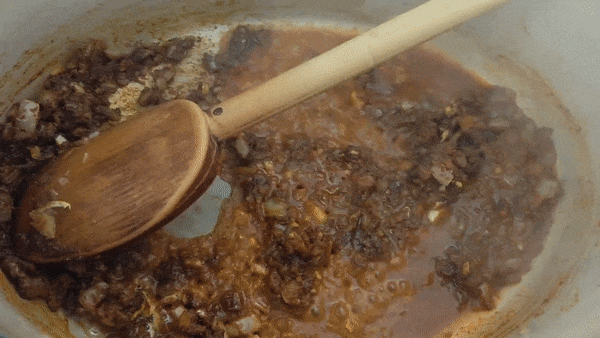
Then in went 125 ml of rose wine (I'd have used white if I'd had any, but whatever...) and about 500 ml of chicken stock, and everything got stirred very well together.

After that, the duck got chucked in and the pot was covered and left to simmer for 45 minutes or so. Normally this would be the time a raw chicken would need to cook, and naturally the duck was well cooked already: but it seemed to me that another 45 minutes getting even more tender couldn't hurt it.
So that was what happened. At the end of 45 minutes, the duck was removed and set aside while I got busy with finishing the sauce. You lower the temperature in the big pot until the pre-sauce liquid is just barely simmering. Then to thicken it, you use about a cup of the thickest sour cream you can lay your hands on, with a third of a cup of flour beaten into it very well with a fork. At which point you should be able to do this with the fork:

Now you find a big balloon whisk and start whisking this mixture into the pre-sauce, sort of a tablespoon or two at a time...making sure each dose of sour cream + flour is very well beaten in, leaving no lumps, before adding the rest. When it's all in there, you very gently raise the heat, stirring or whisking occasionally, until the sauce starts to thicken. Then add the meat back in and let it warm through in there for a little while longer: ten or fifteen minutes should do it.
Assuming that people are ready to eat, you heat the spaetzle (and toss it with some butter), plate it up, and add the paprikahendl on top. And dig in.
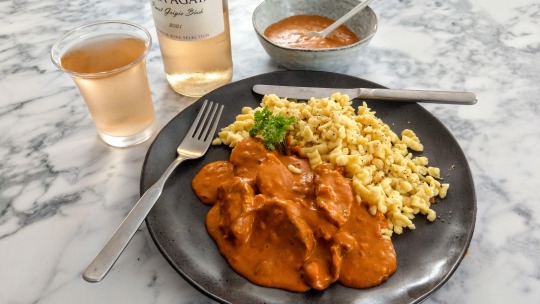
...Anyway, that was my take. If you go googling for "paprikahendl", you will find many, many more recipes: some far less complex than this approach, some far more so. Pick one that suits you and see what you make of it. This one worked really well, though: so you might like to take a shot at it.
If you do: enjoy!
587 notes
·
View notes
Text
Sugar Papas ( Sugar Daddy Headcanons)
I’m stressed about financial things right now so let’s discuss Sugar Daddy Papas. This is very self indulgent.
tw: sfw mostly, a little bit suggestive, mentions of surgery, fluff
Primo
You make him feel young again and he loves indulging you in the things you enjoy. If you’re going to school or you have a passion project he’s more than happy to fund them. Loves to take you with him to vineyards and fancy high society events. Will bring you to tour world famous botanic gardens and spoil you the entire trip.
Probably goes to expensive luxury country clubs and brings you along— there’s a massage and spa service and you always get a nice day of relaxation. You relax in the hot tub together and sometimes things get a little frisky because he just can’t resist that little pleased look on your face when you’re enjoying the heated water and a cold fancy drink that’s sitting on the edge, there’s music playing and not too loud— it’s a good life. You’re pleased and fuck if that’s not the hottest thing to Primo.
Secondo
Loves dressing you in expensive dresses and/or suits and showing you off on his arm. If you like feminine clothing he’ll take you to very fancy boutiques and wait while you try on dresses and the like. You always get 100% of the store’s attention and service because they know that Secondo will spend so much money if you like a particularly outfit. If you prefer masculine clothing, he takes you to expensive tailors and personally finds the best and most suitable fits for you. He’ll suggest several designs, but if there’s something you really have your heart set on he has no problem whipping out his credit card for you.
After retirement he enjoys traveling around Europe and will bring you with him. You always fly first class and his favorite game is ‘how far can we go before the flight attendant gets suspicious’. You have to learn to be quiet very quickly because Secondo has some very talented fingers that wander a lot. What you don’t know is that he’s already paid the crew off to not bother the two of you.
Loves to watch beautiful sunrises and sunsets with you so he always finds accommodations with the best views. He buys the finest wine and loves having you try his favorites or ones that are native to the region or area you are visiting. Loves to hear your opinion of everything— the wine, the food, the countryside. Could listen to you talk for hours.
Terzo
This man buys the most expensive lingerie for you and has you ‘model’ it for him. Takes you to red carpet events and operas, treating you to fancy five-star restaurants with rich food and good wine. He may have a playboy reputation and you had fully expected for this arrangement to only last a few months, but the two of you are celebrating your third year anniversary soon. He’s planning to fly the two of you out to some exotic vacation spot for a full week of absolute bliss.
Every fancy hotel you visit he insists ‘breaking’ the bed in and after his appetite is sated, he will call room service and let you order whatever you want. Buys you expensive body lotions and oils and massages you, hands running up and down your body as he whispers worship and praises.
If you have a favorite tattoo artist you want a tattoo from, he'll do his best to get you a booking and fly you out. He'll sit there and hold your hand and help you take care of it after. And of course, he'll pay for the whole thing.
Copia
You go with him on tour and the ghouls consider themselves lucky to have you because Copia will book the best hotels for you because you deserve nothing less. You enjoy lazy evenings in between concerts nestled in his lap with your back against his chest as a movie plays on the big screen in your hotel room and Copia slowly hand feeds you fruit or cheese, stealing a kiss after each bite.
He loves to have his hands on you, loves the feeling and reminder that you are his. The expensive clothing you wear, the necklace and watch and shoes, those are all claims to him. Little touches against your shoulder, hand around your waist, lips brushing against your temple, you’re intoxicating to him.
Supportive about plastic or transition surgeries, he’ll pay for it all and it will be at the best places with the best care. He’ll pay for any treatments you want, will help administrator them if needed. He will give you so many affirmations for your body whether it be physical or gender-based, he’s more than happy to please. He just wants you to feel comfortable in your own body. Buys you the most expensive products for care.
Sets up an Etsy account for you and links his card to it— doesn’t care what you buy as long as it makes you happy. Almost cries when you buy a little keychain of him and tell him that way he can always be with you-- he immediately insists on finding someone who does custom art and keychains to get one of you too.
#the band ghost#copia#terzo#secondo#ghost band#ghost bc#primo#papa emeritus iv#cardinal copia x reader#cardinal copia#papa emeritus i#papa emeritus ii#papa emeritus iii#papa emeritus i x reader#papa emeritus ii x reader#papa emeritus iii x female reader#papa emeritus iii x reader#papa emeritus x reader#papa emeritus iv x reader#headcanons
422 notes
·
View notes
Note
Hi!
Do you know if there's any Jewish history in EH? There are a lot of old (pre-Inquisition) Jewish buildings/art in Spain, Catalonia, and Portugal, but I'm not sure if there are EH. I'm just curious, since I've learned a lot about Jewish life in Spain before the Inquisition, but never about Jewish life in EH, if there even was any.
Thank you!
Kaixo and thanks for your message!
Of course there's Jewish history in EH! In Gipuzkoa there never was a big community, as well as in Araba, with the exception of Guardia. In Bizkaia, Balmaseda was the biggest center for Jews, but sadly they were forcibly expelled around 40 years prior to the expulsion from Castile. Jewish people flourished mainly in the southern side of Nafarroa in Muslim times: there were thriving Jewish communities in Lizarra, Tutera, Tafalla, even Iruña.
Luckily this didn't change after the Reconquista! Jewish people were mainly merchants and moneylenders - profession banned for Christians - and they would work with peasants and nobility alike. They were also wine makers, and this wine was very much appreciated not only in the kingdom of Navarre, but also in Aragón and Castile. Navarrese kings supported Jewish communities and welcomed any Jew from other region.
There's a tragic but moving story about this time. The Jewish community of Gasteiz was forced to leave, but they agreed to hand over their cemetery to the city on the condition of respect the ground and don't build on it. The promise was respected for 460 years until 1952, when Jewish representatives agreed with the town hall that the ground was available for any use. Nowadays, it's a park with this monument to Jewish people. The neighborhood is called Judimendi, "the mountain of Jewish people".
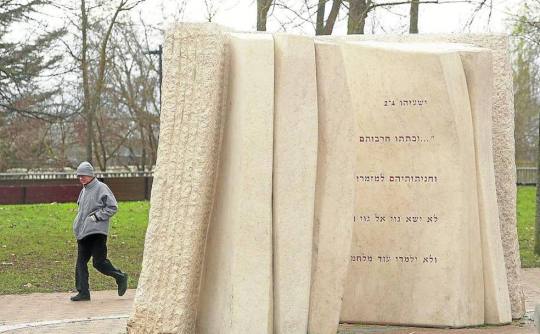

In fact, when the kingdom of Castile ordered the expulsion of Jews from Castile, most of them moved to the kingdom of Navarre. But after the conquest by Castile in 1512, Jews and Muslims were effectively expelled from their home. Most of them didn't go too far, just across the border, to Baiona.
Baiona welcomed Basque, Spanish and Portuguese Jews, gathering a very important community that led to call the town the little Jerusalem at one time. There's a much modern legacy there than south the border, for example, there's still a functioning synagogue.


After the French revolution, Jews were reocgnised the same rights and duties than any other French, so they kept their businesses and in Baiona, many of them devoted themselves to chocolate - still one of the best in Europe, I must add.
But during WW2 and nazi occupation, maaaany of these Jewish people were captured and led to extermination camps. The community didn't die, though, and they welcomed a new wave of Jewish refugees in the 60s due to the French-Algerian war.
René Cassin, one of the fathers of the Declaration of Human Rights, was a Jew from Baiona, btw.
Nowadays in Euskadi there are just around 300 Jews, while in Iparralde this figure is bigger but not super high (just around ~3,000 in the whole Aquitaine).
55 notes
·
View notes
Text
Traveling the most beautiful places this 2024:
“Visit to Europe (Vienna)"

In my opinion, traveling is the most interesting thing that is liked by almost half of the people on Earth. Traveling is an adventure that broadens horizons, opens minds and enriches lives. It makes the person happy and fresh of any age, whether it’s about exploring exotic destinations, immersing oneself in different countries and cultures, or simply seeking relaxation in nature and embrace.
Traveling to different countries in a very short time is very difficult to memorize, and making all the events perfectly fully organized or managed is a big task, but having something that makes us memorize about our events in advance is a big support, like tinyti.me website makes this problem easier in today's world by making their website available for us to create events which help in perfect management.
I think Vienna is one of the most beautiful cities in Europe. The historic core of the city is a massive UNESCO Heritage Site brimming with incredible museums, beautiful galleries, and sprawling Baroque palaces.
The city is a history buff’s dream. There’s an incredible café culture, a nearby wine region, tons of amazing eateries, awesome live music (including world-class opera), and much more.
I’ve been coming here for years and I never get tired of visiting. Technically speaking I love the city so much that I used to run tours here!
Naturally, I’ve stayed at countless hotels during my visits. Here’s my list of the best hotels in Vienna:
1. Hotel-Pension Wild
This two-star hotel is one of the few affordable lodgings in the city center. It has simple but bright rooms that feature comfortable beds, plenty of space, and large windows that let in a lot of natural light. The design is a bit dated (the carpeted rooms don’t look particularly stylish) but everything is clean and functional. Rooms include basic amenities like a flatscreen TV, desk, and free Wi-Fi. The bathrooms are pretty small, but they’re clean and the showers have good water pressure. The hotel offers a hearty continental breakfast and the owner is friendly and welcoming. If you’re on a tight budget, there are small, no-frills single rooms with a shared bathroom available as well.
2. Hotel Domizil
This boutique four-star hotel has small, clean rooms with décor that makes you feel like you’re back in Vienna’s imperial past. The rooms have plenty of light and lots of antique touches, such as wooden desks and tables, and upholstered armchairs. Rooms also have free Wi-Fi, a flatscreen TV, and a coffee/tea maker. The bathrooms, while not particularly fashionable (the tiles are kind of ugly), are very spacious and the showers have excellent water pressure. The breakfast, which can be included in the price, has tons of variety, including lots of different fresh breads and cheeses.
Located in the city center, I think this is one of the best value places to stay if you want to be in the center of it all.
3. Hotel Mozart
One of the few hotels in the Rossau neighborhood (just northwest of the city center), this budget-friendly three-star hotel boasts large rooms with lots of natural light. Rooms are spacious and decorated in light colors and feature hardwood or parquet floors. There are lots of other wooden touches too, such as desks/tables, and large wooden headboards. Free Wi-Fi is included, as is a flatscreen TV and AC (a must if you’re visiting in the summer). Some rooms include coffee machines. The hotel boasts a filling breakfast spread each morning with lots of fresh fruit and pastries. There’s also a bar on-site and the staff are always happy to share their tips and advice too.
4. Hotel Johann Strauss
Located in the Wieden neighborhood, this stylish four-star hotel is named after the eponymous 19th-century Austrian composer. The hotel is set in a historic Art Nouveau building that’s been entirely renovated, with rooms that have lots of natural light and a soft, welcoming color palette. Rooms include a flatscreen TV, minibar, coffee/tea maker, desk, and sofa. I really like that there’s a lot of art around the property, including in the rooms (naturally, much of the art is music centered). The tiled bathrooms are huge, with lots of light and great water pressure. I especially like that the breakfast buffet is enormous and features a lot of variety. The staff is exceptionally friendly too and happy to help you make the most of your stay.
5. Hotel Am Konzerthaus Vienna
Located in Landstrasse near the iconic Belvedere Palace, this luxe four-star hotel feels more like a five-star property. It has a chic lobby and large, bright rooms with super comfy beds. Everything is fashionable and trendy, with lots of rich colors from a darker palette. The large bathrooms are bedecked with dark tiles and are well lit, featuring plush bathrobes and relaxing rain showers. Rooms also include a flatscreen TV, desk, and coffee/tea maker. The breakfast buffet is huge and has a lot of options, but I especially love that the on-site restaurant has a Michelin star (it does amazing modern takes on traditional Austrian dishes).
The hotel is a perfect choice for travelers who want some luxury without breaking the bank.
6. The Ritz-Carlton Vienna
This is arguably the fanciest hotel in town. A five-star property right in the heart of the city, this hotel is spread across four historic palaces (yes, actual palaces). While the hotel feels palatial, it has understated décor with a chic minimalist design (think lots of white space with touches of color or artwork). The marble bathrooms are huge and the showers have perfect water pressure. The rooms are also massive and have big, comfy beds (as well as desks, AC, sofas, and electric kettles).
There’s also a gigantic breakfast buffet offered each morning and a free glass of champagne when you check in. The hotel also has a pool that plays music underwater, a fitness center, sauna, steam room, and three different spas on-site. In short, it’s the pinnacle of luxury in the city and the best choice for travelers looking to splurge on an elegant stay.
I hope this blog helps you a lot when traveling next time to Europe (Vienna), So, whether you're embarking on a solo adventure, a family vacation, or a romantic getaway, This spirit of travel guides you on a journey of exploration, discovery, and adventure.
44 notes
·
View notes
Text
Italy Yacht Charter Guide
Italy offers art, food and fine wine in spades, but there is so much more to see in this beautiful country, particularly when sailing along the stunning Italian coastline. Travelling the Amalfi coast by luxury yacht offers picturesque coves, clear waters, and incomparable views of the region’s landscape and charming harbors, such as the colorful Positano.
The nearby island of Capri is a shopper’s paradise, and for indulgent relaxation, Ischia’s thermal spas are unmatched. Beyond the Amalfi, discover the rugged Sicilian coastline, the chain of islands in the Tuscan archipelago, the volcanic Aeolian Isles, picturesque Sicily and the jewel of the Italian Rivieria, the Cinque Terre.
According to mythology, the Tuscan isles - Elba, Gorgona, Capraia, Giannutri, Giglio, Montecristo, and Pianosa – were formed when Venus rose from the waters and dropped seven pearls from her necklace into the sea. Since obtaining protected status in 1986, the marine life in the archipelago’s national park has flourished, making this an unmissable sailing destination
Sardinia is a true yachting haven, with intense, turquoise waters renowned for their sparkling clarity. Boasting a plethora of secluded coves, gleaming white beaches, gorgeous coastal villages, and rugged scenery, this is an island best discovered from the water.
As you approach the large island of Sicily by sea, your view is dominated by the imposing Mount Etna, the largest active volcano in Europe. Sailing north of the island into the Tyrrhenian sea brings you to the Aeolian archipelago.
Consisting of seven main islands and a host of smaller islets, the volcanic Aeolian archipelago takes its name from Aeolus, the Greek god of the wind. Named a UNESCO World Heritage Site in 2000, this diverse region has a stark volcanic beauty. Active volcanoes with smoking craters, thermal pools, towering rock formations, and black sand beaches make for a unique Italian island-hopping experience.
7 notes
·
View notes
Text



National Rice Pudding Day
All we can think of is a bowl of some good old rice pudding this National Rice Pudding Day taking place on August 9. For many of us, starting from our childhood to our adulthood, rice pudding has been a staple in our diets. Made with a base of rice cooked in milk and sweetened with sugar, syrup, or honey, rice pudding can be found in many cultures and cuisines all over the world. Of course, each region has its own unique take on the dish. Some add nuts and spices like nutmeg, cinnamon, or cardamom to it, while others throw in a dash of wine to give it that wow factor. For a more fragrant look and feel, many people in the Middle East also add pistachio slivers and rose petals before serving it. You can have it hot or cold, and as a breakfast dish or a dessert after dinner. So, how are you having your rice pudding on August 9?
History of National Rice Pudding Day
National Rice Pudding Day celebrates the ancient rice pudding dish in all its glory and greatness. While we may know the sweet version of the dish today, did you know that it actually started out as a savory treat? It is difficult to pinpoint the exact location and time of the creation of rice pudding, but many scholars believe it may have originated in either ancient China or in ancient India. Both these countries have a long history of including rice as well as sugar in their religious and cultural activities, so it only makes sense that the combination of the two may have been included in their cuisines as well. ‘Kheer,’ which is Hindi for rice pudding, was first recorded in ancient India in 6000 B.C., and it was included as a staple in a prescribed Ayurvedic diet regime. It is also interesting to note that the early versions of the Indian rice pudding did not actually include rice or sugar. In place of rice, Indians made use of the cereal grain known as sorghum.
Elsewhere in the world, rice pudding was being made with rice. The grain had reached Europe through exports delivered by water or the Silk Road in the 1300s. Because it was being exported from Asia and was not being grown in Europe, rice automatically became extremely expensive. Thus, rice pudding could only be enjoyed by the elite and royalty of European countries. Before the 1500s, rice pudding was savory in nature. It was made with rice being boiled in a broth with saffron and almond milk. Chefs started including sugar into the dish to make it sweet, and soon a sweetened rice pudding started gaining popularity. It was in the eighteenth century that rice pudding became more commonplace and less expensive, all thanks to globalization. The lowered rice prices meant the grain was in easier reach of the masses, and in today’s world, it is considered to be a cheap, but filling meal.
National Rice Pudding Day timeline
6000 B.C. Indian Rice Pudding for Healthy Living
Ancient India includes rice pudding in the Ayurvedic diet in order to ensure healthy living.
14th Century Forme of Cury in England
Rice pudding, known as Forme of Cury or rice pottage, is made with rice, almond milk, and saffron in English Royal kitchens.
17th Century Sweetened Rice Pudding Recipes
Some of the modern-age rice pudding recipes come from the Tudor time period, and are called ‘whitepot.’
18th – 19th Century Rice Becomes Cheaper
Rice grains become cheaper, allowing access to the public who can now enjoy rice pudding treats, unlike their predecessors.
How To Celebrate National Rice Pudding Day
Make rice pudding
Have a rice pudding contest
Try a new rice pudding recipe
Take a trip down memory lane and make your favorite rice pudding recipe. Because of its versatility, you can choose to have it hot or cold, and for breakfast, lunch, or dinner. Rice pudding is one of the highest-rated comfort foods out there because of its gooey, yet grainy texture that leaves one filled with love and warmth.
Participating in a rice pudding competition is one of the best ways to celebrate the day. There are two ways you can go about doing this. You can either hold a rice pudding cooking competition or you can have an eating competition. Whether you choose one, two, or have both, it’s going to be a fun-filled day.
Going back to what is tried and tested can be comforting, but seeking out the new can reward you with invaluable experiences. Give new rice pudding recipes a try. It could be a sweet or a savory recipe, the choice is yours.
5 Facts About Rice That Will Blow Your Mind
Sticky rice for strong cement
White rice is brown rice
Rice is grown everywhere but Antarctica
The shelf-life is decades long
Good for health
The Great Wall of China is held together with sticky rice that has been mixed with calcium carbonate.
All white rice comes from brown rice, and this is because the white rice has the brown coating of bran removed.
Rice is grown everywhere except Antarctica because of the continent’s extremely cold temperatures.
Rice, when stored in a cool and dry environment, will be good to consume for the next 10 to 30 years.
Because rice contains several minerals and antioxidants, it is great for your health, particularly for your skin.
Why We Love National Rice Pudding Day
It’s a celebration of rice pudding
It’s a celebration of ancient times
It’s a celebration of a staple food item
Rice pudding has come a long way in terms of development. It has been enjoyed by millions for centuries. With easy-to-make recipes and simple yet enjoyable taste, rice pudding is loved by many all over the globe.
A look into ancient history will reveal a lot of information on how people led their lives in order to ensure healthy and peaceful living. One historical overview of rice pudding allows us just that benefit of looking into how human civilizations utilized a single rice pudding dish in their daily lives.
Rice is a staple food item for many countries in the world. In fact, 50% of the world’s population consumes rice on a daily basis. Apart from helping our skin stay smooth and supple, rice also aids in healthy hair, is good for our overall health, and keeps our tummies filled and happy.
Source
#National Rice Pudding Day#NationalRicePuddingDay#9 August#food#dessert#Spain#España#Rice pudding with cinnamon#vacation#travel#original photography#tourism#summer 2021#national food#spoon#plate#glass bowl#Southern Europe#Milchreis#Arroz con leche#restaurant
5 notes
·
View notes
Note
You may have already made a post about this so sorry if so, but what are your headcanons regarding how Matt and Katya met? And how they kept touch over the years?
Love your content btw!!
Thank you! And actually, somehow, no one has asked me that on any of the blogs! I had to think and coalesce some thoughts. This got long so I am going to split it into two parts but their meeting!
The Trans-Canada railway was completed in the 1880s and finally opened up what was called the ‘last best west.’ Between the Canadian Rockies in the far west and the western edge of the woodlands that define eastern Canada in Manitoba, the prairies stretch out in what looks to a child of the eastern woodlands like a vast treeless void. Grasslands and steppes are incredibly ecologically important, but I am ethnically a clinker-built canoe lover, and they scare the shit out of me. Judging by settlement patterns, most French Canadians agreed. As the American West closed, some Americans were willing to join Canadians and take land ripped from indigenous peoples too. Alberta was a result. Concerned about American settlement, in 1896, the Dominion of Canada’s federal government coordinated with the foreign office of the British Empire to look for more settlers. At the same time, in what was then the Austro-Hungarian empire, Galicia was likely the poorest place in continental Europe, with the only other comparable example being famine-era Ireland. The other Ukrainian-speaking areas of the Austro-Hungarian empire (75-80 of that territory was held by the Russian Empire) weren’t much better off. Each government found a solution in the other. Britain, representing Anglo-dominated Canada, and the Austrians shook hands, and the flow began. The US saw the largest share of Eastern European immigration in this period, but the majority who sailed to Canada were Ukrainians. And even before immigration, the region's international ties were based on Canadian financial interests. So, what does this mean for Katya and Matt?
The scene I imagine is that while the powerful wheel and deal, two products of empire crossed paths. One of these meetings may have taken place during a summer folk festival. Girls wove wreaths of flowers into their hair and floated others down the river. Songs were sung, vodka and wine flowed, and dancers joined hands. While the Austrians and the British bargained, a young man not so far removed from his peasant roots and his own saint’s day celebrated with fire and river wandered into the edge of a valley clearing at the end of the longest day of the northern year. As a maple or spruce was decorated, the sun sank, and the last light of day fell like fire light onto a Carpathian river valley. Bonfires were lit. Against a world on fire, a child of the woodlands looked upon the silhouette of his future, crowned with birchwood silver woven into her braids. Katya sensed him, a being like herself from across the world and turned. She looked at him a long moment, with eyes belonging to a world since passed set in the face that would one day be the image that sprang into Matthew’s mind when he needed to summon a memory of home that would not cleave him in two. She bid him to approach and, with one gesture, changed their fates.
Later, he would find out she spoke the court French of his earliest years, but this night, there is only Katya’s outstretched hand and burning blue eyes reflecting fire and Matt’s fingers lacing into hers to spin in the dance of all the other young men and women. There is no discussion of soil and wheat, nor opportunity and affection. There is only alcohol, laughter, music, fire and spinning, his mouth full of her language, unknown but already familiar. There is only a lightening of her eyes as she enjoys herself, her head flung back in laughter as he chokes on pear horilka stronger and sweeter than any whiskey he’s ever made. Her wreath topples out of her hair, and she bursts into laughter as he snatches it up and runs, calling over his shoulder, and she hikes up her skirts and follows, hand outstretched, only to grasp onto him and run, stride long and confident as they leap together to make it over the bonfire.
Still, together, hands clasped, his right her and left and left touching the laurel wreath, the last symbol she indulges from her Varangian roots. Eye contact, a significance, a weight that will one day balance the heaviness of history. She will press his heart into the shape of hers with that weight. He will give it back in every way he can, the ballast of whatever love she’ll let him give. But for now, in the last light of day, there is only a young man and a young woman hand in hand, circling a fire under a night sky. Here, they are under a star-streaked Milky Way that gives way to a mead moon rising over the mountains. Someday, save them; that moon will be the only witness to this night when mortality leaves alive only a man, a woman, and their most human memory.
#the ask box || probis pateo#canukr#katya || бо лишало на серці сліди#matthew || my country is winter#katya and matt || the soil of our souls#hws ukraine#hws canada
47 notes
·
View notes
Text
Discover the Enchanting Beauty of Germany 🇩🇪
Germany, a land of rich history, stunning landscapes, and vibrant culture, offers an unforgettable experience for every traveler. From the bustling metropolis of Berlin to the charming Bavarian Alps, there's something to captivate everyone.
Immerse Yourself in History and Culture 🏛️
Berlin: Explore the remnants of the Berlin Wall, visit iconic landmarks like the Brandenburg Gate, and indulge in the city's thriving art scene.
Munich: Experience the Bavarian charm with its lively beer gardens, majestic castles like Neuschwanstein, and the annual Oktoberfest celebration.
Cologne: Discover the iconic Cologne Cathedral, a masterpiece of Gothic architecture, and enjoy a boat cruise on the Rhine River.
Explore Stunning Natural Landscapes 🌲
Black Forest: Hike through lush forests, visit charming villages, and indulge in delicious Black Forest cake.
Bavarian Alps: Enjoy breathtaking mountain views, go skiing or hiking, and relax in traditional alpine chalets.
Rhine Valley: Cruise along the Rhine River, admiring picturesque castles and vineyards, and savor local wines.
Indulge in German Cuisine 🍻
Savor traditional dishes: Enjoy hearty meals like sauerbraten, schnitzel, and bratwurst, accompanied by a refreshing beer.
Experience local markets: Discover fresh produce, artisanal cheeses, and delicious pastries at vibrant farmers' markets.
Indulge in sweet treats: Treat yourself to Black Forest cake, apple strudel, or pretzels.
Practical Tips for Your Trip ✈️
Best time to visit: Spring (April-May) and autumn (September-October) offer pleasant weather and fewer crowds.
Transportation: Germany has an excellent public transportation system, including trains, buses, and trams.
Language: While English is widely spoken, learning basic German phrases can enhance your experience.
Currency: The Euro is the official currency.
Germany is a country that will leave you enchanted with its diverse landscapes, rich history, and warm hospitality. Start planning your dream trip today!
Would you like to focus on a specific region or interest?
https://www.youtube.com/@dreamtrip2030ma
#travel#world#Germany#Munich#Berlin#Frankfurt#Europe
2 notes
·
View notes
Text

CAMDEN'S ANNUAL ITALIAN STREET FESTIVAL:
Location: The Borough of Camden.
Hosts: The British-Italian community of London.
Date: 19th of July - 21st of July.
Dress Code: None.
EVENT SUMMARY:
It's once again time for Camden's annual celebration of Italian pride! Whether you hail from the homeland or not, all are welcome to come and enjoy a weekend celebrating one of Europe's richest and most beautiful cultures. There will be distinct representation from Sicilia, Lazio, Calabria, Abruzzo, Veneto, and of course, thanks to London's thriving Neapolitan community, Campania, all showing off the best their region has to offer.
The well loved and long established festival brings together people from all over the city to enjoy good food, even better company, and endless entertainment. The canals will be lined with tables for people to dine at; catered to by the authentic street vendors and fresh food stalls boasting the best Italian cuisine outside of the country itself. The market will be transformed to offer art, clothing, wine, and much more, created either by the community itself, or imported directly from Italy. When evening starts to fall, though? Grab your sambuca shots, wait for the music to fill the air, and watch as the real party begins.
Primrose Hill will play host to a mini music festival all of its own on all three days, with a spotlight on both upcoming and established British-Italian musicians throughout the day and well into the night. Rumours say there might even be some guest appearances from Italian artists, too. And yes, there will be pop up bars and grab-and-go Neapolitan pizza ready for you. We're not forgetting this is still London and you're all messy af...
MAIN POINTS OF INTEREST:
Cheese & Wine Tasting (Friday afternoon) - What better way to get things started than sampling Italy's two most beloved exports? Offering a spectacular selection of Sicilian wines (thanks @ Mount Etna for your service), a laid-back wine tasting event will take place for anyone (old enough, you little shits) to enjoy. You'll also get to vote which region has the best cheese. Fight to the death, tbh.
Dinner & Dance (Friday night) - Once you're all sufficiently drunk on Sicily's offerings, the traditional live bands will start to play canal-side. Laze beside the water with your dinner, enjoy the warm weather, and be transported to the streets of Italy as you eat your bodyweight in pasta.
Pizza Making (Saturday afternoon) - If you're not too hungover from necking sambuca shots at the festival in the park, or from finishing that bottle of wine you probably shouldn't have, try your hand at making authentic Neapolitan pizza with some of the best chef's Camden's Italian scene has to offer. What do you win? Pride, bitch. That's all you need. You're Italian.
A Taste of the Opera (Saturday evening) - Fancy a spectacular rendition of Rigoletto? Probably not, you cultureless heathens, but the offer is there... Enjoy Verdi's masterpiece in the local community theatre, courtesy of the local youth operatic society. Support the local arts, bro.
Mini Venetian-Style Carnival (Sunday afternoon) - Yes, of course it's after Mass, don't worry... Head back down to the canal once more to watch London's best attempt at capturing the beauty and artistry of the Venetian Carnival. You'll also have a chance to make your own Venetian-style masks with the help of local artists. The creepier looking the better, apparently.
Drunk Shenanigans (All nights) - Because there's alcohol available from the vendors, and you've got an excuse to party in the streets? Go wild, bro.
6 notes
·
View notes
Text
Luxury Wine Cruises

Unforgettable Wine River Cruises: Experience The Perfect Blend Of Wine Culture And Luxury
We celebrate wine and treat our guests to a wonderful selection of regional wines across all of our river cruise itineraries – however, many guests wish to take their passion for wine a bit further. Is there a winery whose bottles dominate your dinner parties? If so, you may be able to travel along with their wine club on one of our exclusive Celebration of Wine River Cruises with Savvy Travelers.
Sip, Savor, and Enjoy
Savvy Travelers offers over 70 annual Wine Cruises through Europe’s iconic winemaking regions. Each cruise is hosted by a wine professional who brings “New World” bottles for you to enjoy. Experience curated tastings, visit historic cellars, and compare wines from different regions.
Choose Your Ideal Wine Experience
Our Celebration of Wine River Cruises are guided by enthusiastic wine professionals. They lead tastings, accompany you on shore excursions to vineyards and cellars, and curate special food and wine pairing dinners. Discover the perfect blend of travel, wine, and cuisine.
North American Wine Host Sailings
Sample European wines in their native regions and compare them with selections from a North American winery. Enjoy tastings of New World and Old World wines while exploring the history and culture of the area.
European Wine Immersion Sailings
Immerse yourself in the local wine culture with an expert in European wines. Learn about the region’s history and varietals, and get insider tips on local delicacies and must-visit spots.
Epicurean Experiences
Premier Vineyards and Cellar Tours
Visit unique vineyards and wineries like France’s Château de Montaigne and Austria’s Burg Clam. Taste the history and heritage of these storied vines.
Authentic Encounters
Connect with artisans and vintners. Learn to pair chocolate with wine, discover the process of making olive oil, and enjoy Austria’s Wachau Valley apricots.
Food and Wine Pairing – A Unique Art
Experience dinners with wines perfectly chosen to complement your meal. Enjoy pairings like rosemary-crusted lamb with Châteauneuf-du-Pape and oysters with a Loire white.
Regional Wines
Our Celebration of Wine River Cruises feature an extensive selection of regional wines. From Bordeaux's robust reds to the crisp whites of the Rhine, each glass tells a story of its terroir, complementing the culinary traditions of each region.
Bordeaux, France: BlendsBordeaux is famous for its blends of Cabernet Sauvignon, Merlot, and Cabernet Franc. Enjoy complex and balanced wines with notes of dark fruit and spice.
The Seine River, France: Champagne and CalvadosEnjoy the sparkling luxury of Champagne and the rich flavor of Calvados, an apple brandy from Normandy.
The Rhone River - Provence, France: Rosés, Hermitage, and the "Pope's Wine"Savor refreshing Rosés and robust Hermitage reds, including the famous Châteauneuf-du-Pape.
The Douro River, Portugal: Port Wine and Vinho VerdeExperience rich, fortified Port Wine and the light, slightly effervescent Vinho Verde.
The Upper Danube River - Wachau Valley, Austria: Grüner Veltliner and RieslingEnjoy crisp, aromatic wines like Grüner Veltliner and Riesling from the Wachau Valley.
The Lower Danube River - Hungary, Croatia, Serbia, Bulgaria: Szekszárd, Tokaji, Plum Brandy, and SeherezadaTaste Hungary’s Szekszárd reds, sweet Tokaji wines, traditional Plum Brandy, and Seherezada from Serbia.
The Rhine River, Germany: Rieslings, Crémant d'Alsace, and Kölsch BeerEnjoy versatile Rieslings, sparkling Crémant d'Alsace, and refreshing Kölsch beer.
The Moselle River, Germany: RieslingsSample some of the world’s finest Rieslings with bright acidity and fruity notes.
The Main River, Germany: Silvaner, Müller-Thurgau, and RauchbierDiscover Silvaner, Müller-Thurgau, and the unique smoked beer, Rauchbier, from Bamberg.
Book Your Celebration of Wine River Cruise Today
Join Savvy Travelers on a Celebration of Wine River Cruise and explore Europe’s finest wine regions. Reserve your spot today and get ready to sip, savor, and enjoy an unparalleled wine adventure!
#wine river cruises#wine cruise itineraries#european wine cruises#european wine tours#luxury wine cruises#bordeaux wine blends#seine river champagne#rhone river rosés#douro river port wine#wachau valley wines#danube river cruises#wine tasting cruises#rhine river rieslings#moselle river wines#main river silvaner#european wine immersion#wine and cuisine cruises#wine pairing dinners#vineyard tours#cellar tours#european wine culture#gourmet wine cruises#wine lover's dream cruises#best wine cruises#wine lover's cruises#wine travel experiences#cultural wine tours#wine regions of europe#european wine regions#savvy travelers wine cruises
0 notes
Text
The Spot where Sausage is Supreme and Charcuterie is above all the rest. Among the best places to eat at the historic plaza in the town of Sonoma is The Sausage Emporium. Few people know the real details about sausage and “cold cuts” as owner Miranda Ives does.
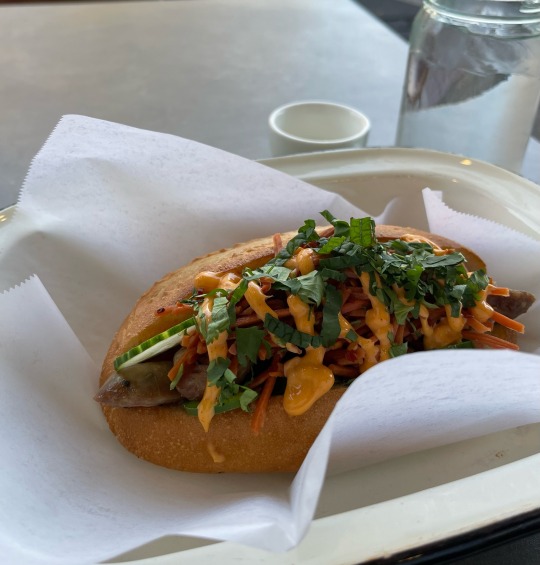
She also knows how to pair beverages with the right combination of sausage and meat. This reporter had the opportunity to chat briefly with Ives while enjoying a favorite of mine from the regular menu.
The Vietnamese Banh Mi, made with The Sausage Emporium’s own pork sausage, paté, house pickled carrots, cucumber, cilantro, fresh mint, jalapeño and sriracha creme is yummy. What surprised me was the fresh baked bread-roll (actually it’s a short baguette) it was served in. The aroma alone made for an exceptional culinary experience as that baguette was soft yet slightly crisp and warm. The reviews and ratings for the Sausage Emporium are high and raves.
The harmony of hot, spicy and subtle tangy flavors was very satisfying. The other aspect to The Sausage Emporium I noticed is that there’s a variety of sausages and meats that can gratify just about any palate.
Being in Wine Country, Ives knows her stuff and can prepare a dish that will do more than impress; it takes the taste buds to new levels of experience. Being able to pair a particular wine with a food is a talent and I think it’s crucial.
For example, there are many wonderful wineries and wine-makers in the Sonoma Valley that are eager to have their wine served at a restaurant. Yet in efforts to sell wine and promote it, few tasting rooms take the time to really pair food with what they want to sell.
A really fine Cabernet Savignon like the one I had at the Zina Lounge at the Ledson Hotel, a glass of something sparkling at SIGH, or a Petite Syrah such as the one offered at St. Francis upvalley in Kenwood needs to have something exceptional to go along with it.
Ordinary grocery store cold-cuts truly don’t do a fine wine justice. I’m sorry to say that some of the tasting rooms at the plaza and elsewhere don’t understand this fact. A Sonoma or Napa Valley wine that can truly rival that of any in Europe must have a good food pairing to highlight its own flavor and regional characteristics.
Certainly Sonoma and Napa area can make fine cheeses but quality meat, specifically a sausage or local bologna? Hmm! Here’s where Ives and her staff can help. Charcuterie board servings are popular and The Sausage Emporium makes them.
Not many people know this but to make real bologna or mortadella, prosciutto, etc. is a “slow-food” art. Oscar Meyer or Hormel and others does only the mass produced type; of which Americans are used to.
Pepperoni for instance is essentially an American version of salami, something close to what Italians might call ‘salame piccante.’
As Ives knows, it’s a generic term that means “spicy salami.” It’s made from beef and cured pork mixed together and then seasoned with a blend that usually includes paprika, garlic, black pepper, crushed red pepper, cayenne pepper, mustard seed, and fennel seed.
Ives of course has her own recipe. Still, just about every pepperoni producer uses a different mix and ratio of ingredients, but paprika is always present. The paprika is the ingredient that give pepperoni its color. And most likely according to food historians, perhaps paprika had something to do with the name “pepperoni.”
Only someone like Ives would know that and provide a customer a more discerning understanding of what really good pepperoni is.

For foodies it’s also important to know that The Emporium’s ability to pair food with beverages doesn’t stop at wine and beer. Sausage Emporium serves delicious coffee and is even promoting its own holiday blend just for the winter season called “BeanWrks.”

The Sausage Emporium is Women-owned and operated, with an unpretentious, casual dining area in a memorable and friendly atmosphere, serving breakfast and lunch, along with as mentioned charcuteries, retail sausages, salumi, local wine, champagne, craft beer, and cider.
Open Wednesday through Sunday The Sausage Emporium begins serving breakfast at 8:30 AM and closes after lunch at 3:00 PM. Weekends- Saturday & Sunday doors open at 8:00 AM and close at 4:00 PM. See The Sausage Emporium for website details.

2 notes
·
View notes
Text
Deutschribing Germany: regions
Baden-Württemberg (Baden-Württemberg)

Baden-Württemberg is divided into thirty-five districts (Landkreise) and nine independent cities (Stadtkreise), both grouped into the four administrative districts (Regierungsbezirke) of Freiburg, Karlsruhe, Stuttgart, and Tübingen. The capital city is Stuttgart.
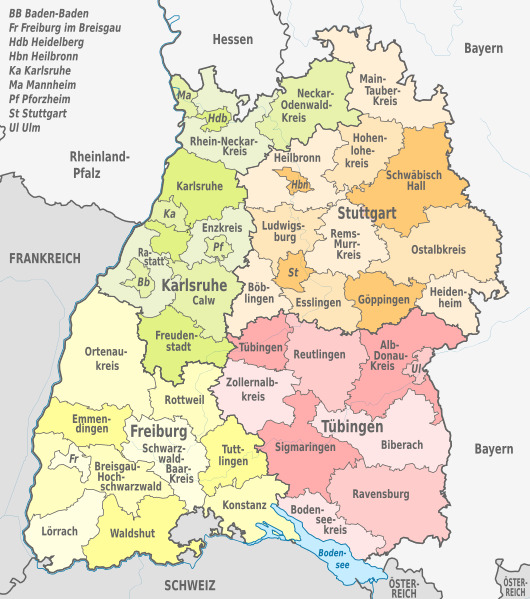
Climate
The predominant climate type is warm-summer humid continental, but the western part (Baden) has a subtropical highland climate. As a result, in most parts of Baden, the climate is warm almost all year round and summers are mostly dry, while winters are wet and foggy.
The rest of the state has more temperate temperatures, especially in summer. Areas of high elevation get snow frequently, and summers are rainier than in Baden.
Due to the climate differences, average annual temperatures range from 5 °C (41 °F) in the Black Forest to 13 °C (55 °F) in the subtropical areas.
Economy
Although Baden-Württemberg has relatively few natural resources compared to other German states, it is among the most prosperous and wealthiest regions in Europe.
The state is known for its strong industries, including car manufacturing, electrical engineering, and mechanical engineering. It hosts the headquarters of some of the largest German companies, such as Borsch, Mercedes-Benz Group, Porsche, and Schwarz Group (owner of Kaufland and Lidl).

Baden-Württemberg is also a popular holiday destination, including a variety of sights like the residential court towns of Ludwigsburg and Karlsruhe, the spas of Baden-Baden, the medieval architecture of Ulm, the Black Forest, and the traditional university towns of Heidelberg and Tübingen.
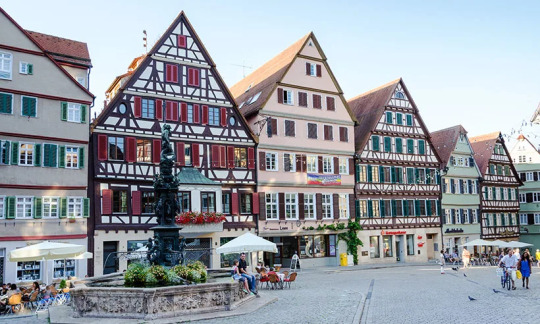
Famous people
Alena Gerber - model, actress, and TV host
Anja Jantschik - journalist and writer
Anne-Sophie Mutter - violinist
Ayla - producer and DJ
Frank Christoph Schnitzler - actor, artist, and musician
Frederik I - Holy Roman emperor
Friedrich Wilhelm Schnitzler - landowner, business manager, and politician
Jens Weidmann - economist
Sophie Weber - singer and younger sister of Mozart's wife Constanze
Walter Haeussermann - scientist
Gastronomy
There are two distinct regional cuisines: those of Baden and Swabia. The cuisine of Baden is considered one of the best regional cuisines in Germany and is based on fruit, herbs, vegetables, game, poultry, fish, smoked products, wine, and beer. It has many influences from Alsace and Switzerland. Specialties include Flammkuchen (pizza with thin crust) and Schäufele (pig's shoulder meat).
Swabian cuisine has a reputation for being rustic but rich and hearty. It is characterized by fresh egg pasta, soups, sausages, broths, and sauces. The most famous specialties are Maultaschen (meat and spinach-filled dumplings, either fried or served in broth) and pretzels.

Schäufele
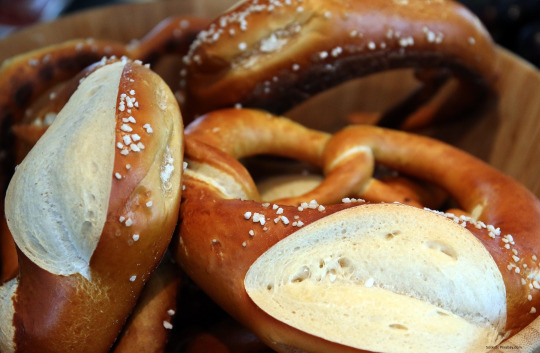
Brezel
History
Baden-Württemberg was formed from the historical territories of Baden, Prussian Hohenzollern, and Württemberg.
100 - Roman invasion of Württemberg
3rd century - the Alemanni force the Romans to retreat west
496 - Frankish invasion
915-1313 - Duchy of Swabia
1083-1495 - County of Württemberg
1112-1803 - Margraviate of Baden
1278-1805 - Further Austria
1495-1803 - Duchy of Württemberg
1500-1808 - Swabian Circle
16th century - Protestant Reformation
1524-1525 - German Peasants' War
1618-1648 - Thirty Years War
1803-1806 - Electorate of Baden; Electorate of Württemberg
1805-1918 - Kingdom of Württemberg
1806-1918 - Grand Duchy of Baden
1918-1945 - Republic of Baden
1945-1946 - South Baden
1945-1952 - Württemberg-Baden
1945-1952 - Württemberg-Hohenzollern
1946-1952 - Baden
1951 - vote on the union of Baden and Württemberg
1952 - State of Baden-Württemberg
1956 - opponents of the merger sue and win
1970 - vote on the restoration of the state of Baden fails
Languages
Two dialect groups of German are spoken in Baden-Württemberg: Alemannic and Franconian dialects. These include East Franconian, High Alemannic, Low Alemannic, Rhine Franconian, South Franconian, and Swabian.
Monuments and landmarks

Baden-Baden

Maulbronn Monastery Complex
2 notes
·
View notes
Text
PINTXOS-PERFECT

Believe it or not, there are one or two people out there who aren’t inspired by the idea of San Sebástian.
The joy of choosing pintxos from the counter ? ‘Health and safety hazard.’ But everything’s fresh! ‘Don’t fancy it’. What about the delicious spider-crab tarts? ‘Don’t like crab’. Gateau Basque? ‘Now I do like cheesecake - but why no biscuit base?’
Thankfully I’ve only experienced this pintxos prejudice from a handful of people. For the rest of you: if you don’t yet know that San Sebástian is the culinary capital of Europe, with more Michelin starred restaurants per capita than anywhere else on the continent, then just tell me which rock you’ve been living under and I’ll send my people round. With delicious morsels of wild mushroom. I’m not a monster after all.
Then there are those who love San Sebástian, have visited it several times, but have only the vaguest recommendations of where to eat. Yes I know. Everywhere is good. But just telling me ‘it’s all about the pintxos’ (no shit Sherlock) isn’t really giving me much to go on. So, for those of you venturing to Spain’s most edible city for the first time, or just can’t remember where you ate last time, here are my top recommendations.
First of all, get yourself on a good food tour. And we went on the best, thanks to a proper, detailed recommendation from my mate Mykayla at work. The first thing you learn about Eskerne, founder of Discover San Sebastian is that she is more revered than the Mayor- and knows more about the history and gastronomy of the region than any mayor. She met us at the Hotel de Londres at 10.30 sharp and deposited us in the park over four hours later, sated and gasping for superlatives about the food we had eaten. This was a PhD in Pintxos - spider crab tartlets, mind-boggling asian-fusion scallops with samphire, wild mushrooms mixed with egg yolk, octopus on sauteed potato…On and on it went, setting off many several taste bombs in my mouth. Do yourselves a favour and book her as soon as you have booked your flights.

But you don’t just have to eat pintxos. My daughter found Bar El Kbzon near the City’s surfing beach. For my money the best of San Sebástian’s restaurants: cafe-informal with stunning views of the beach at sunset, and a menu we ended up ordering in its entirety: best black pudding I’ve ever tasted, heavenly hake and pig’s ear on borlotti beans just three of the reasons to go back. The chef likes Thai food so there were some inspired flavours going on in all of these - plus he makes a mean pad thai if you fancy that.
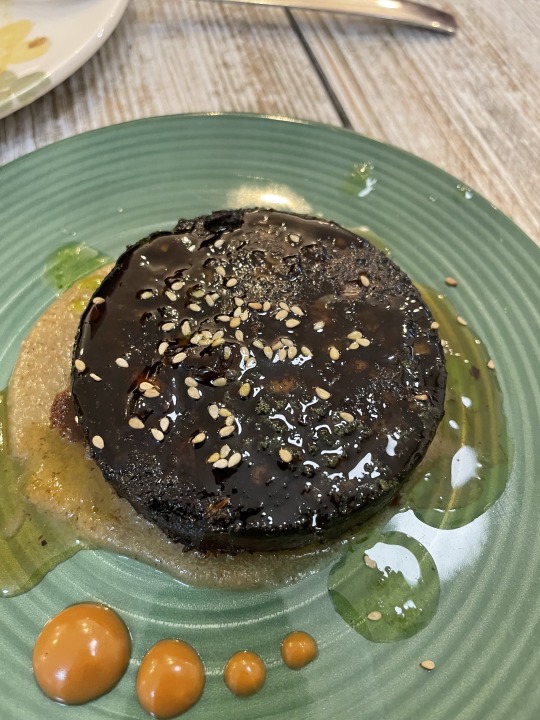
Great places to eat are not limited to the city centre. My cousin and her husband took us to Kako Jatetxea, a bistro with classical charm in a town called Astigarraga, just outside the city centre and famous for its cider houses (the main drink of the region along with Txakoli - more of this later). They had a lot going on in their menu but you can’t go wrong with their surf and turf - a whole pan-fried turbot in a butter sauce and a mammoth rib of beef.
Want to find that ultimate Gateau Basque? Eskerne pointed us in the direction of La Viña and advised us to order just a half portion each. The aggressive rubbernecking required to get to the counter and get attention meant I forgot the Spanish for ‘half portion’ and emerged with the full three slices for each of us. It didn’t matter in the end as we demolished them all in a matter of minutes. We also forgot to order the Ximenez sherry to pour over the gateau - Mykayla says this is a must.
And finally, for super fine dining head to Galerna Jan Edan. I usually prefer generous rustic food to a degustation menu but this one gave us a night to remember: imaginative creations with intense flavours from prawn, pork belly, hake and a strawberry and violet ice cream that over-stimulated my taste buds in the best possible way. All washed down by the region’s signature Txakoli wine (you say Txakoli, I say Chocoli, let’s just pour another glass and forget about it).

There are hundreds upon hundreds of pintxos bars, restaurants, cafes and gelateria crammed into this petite, beautiful and dramatic-looking city. Don't say I didn't tell you - and try making these dishes to get you in the mood.
Crab Tarts
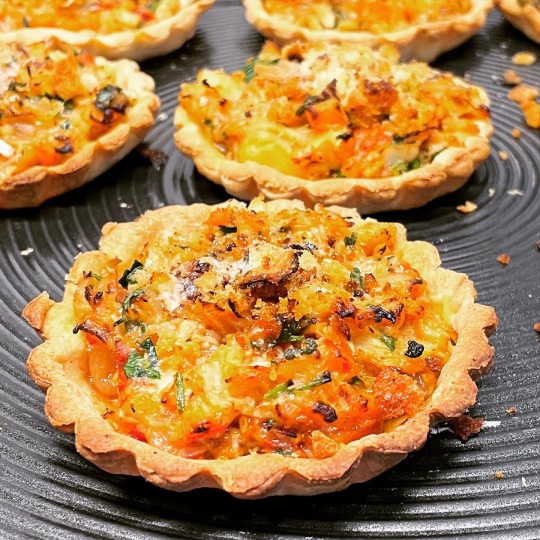
I have done my best to recreate the flavours of the version I inhaled in Ganbera pintxos bar. And guaranteed no soggy bottom-pastry. Serves 4 as a starter.
Ingredients:
250g ready-made shortcrust pastry (or make your own)
3 tbsp extra virgin olive oil
225g white crab meat
Generous tbsp. brown crab meat
1 banana shallot, chopped finely
1 carrot, chopped finely
4 cloves garlic, chopped finely
250ml shellfish stock
60 ml cognac
3 medium tomatoes, skinned seeded and chopped
1 tsp chilli flakes
1 bunch parsley
25g fresh breadcrumbs, browned in a little oil and tossed with chopped parsley
Knob of butter
How to make.
Heat the oven to 200C.
Roll out the pastry and cut 8 rounds to fill 8 individual tart cases. Pop the tins onto a baking sheet and bake blind for 10-12 minutes, remove from the oven and put on the side to cool in their tins. When cool, remove from the tins and place the pastry shells back on the baking sheet.

To make the filling. Heat 3 tablespoons extra virgin olive oil in a frying pan and saute the onions, carrot and chilli flakes for 10 minutes. Add the garlic and fry for another minute or so, then add the tomatoes, salt and pepper, cognac, shellfish stock and 200ml water. Bring to a simmer and continue to simmer until the sauce has reduced and you can drag your wooden spoon through it without the mixture closing up quickly.
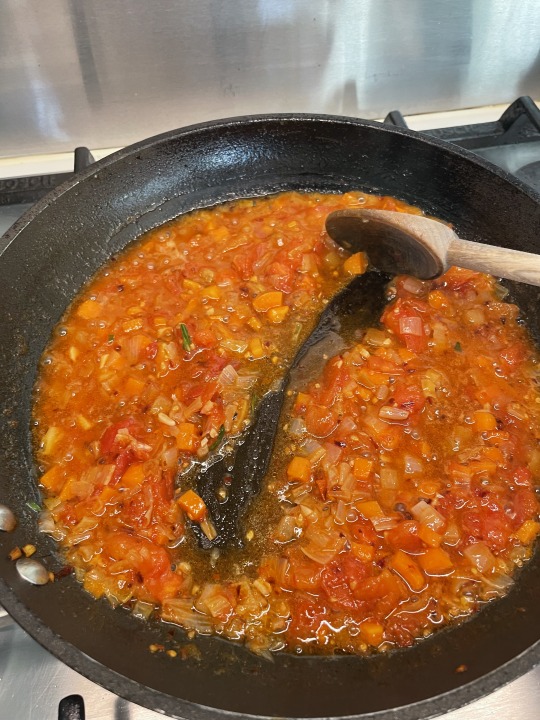
Turn off the heat, add the crab meats and a bunch of chopped parsley. Cool the mix.

Turn up the oven to 220C. Fill each of the tart shells with the crab mixture then top each tart with the breadcrumbs and a small knob of butter. Pop back into the oven for 6-8 minutes until crisp and hot. Serve immediately.
Two Easy Peasy Pintxos
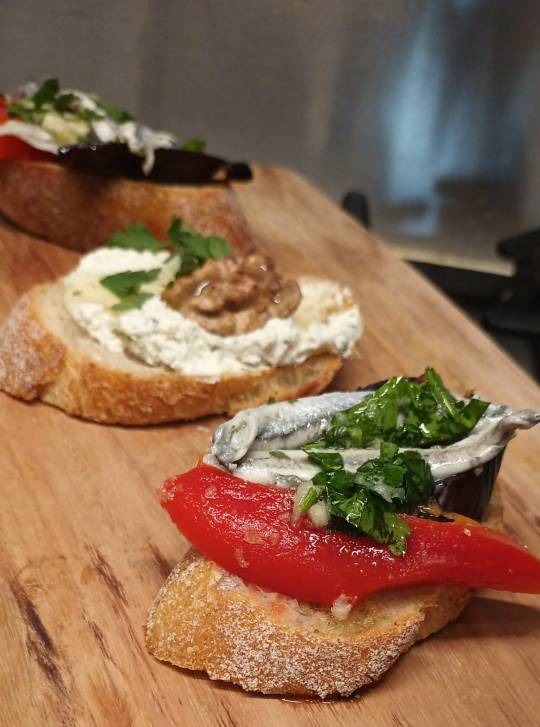
As a parting gift from our tour, Eskerne gave me a copy of Josema Azpeita an Ritxar Tolosa’s The Pintxo Trail. None of the recipes give proportions so I have done the hard work for you while adapting them slightly. Serves 2-3
Pintxos with cream cheese, honey and walnuts
For each person cut 3 slices of a baguette loaf at a diagonal and toast lightly and rub with a clove of garlic. Cool slightly then top with cream cheese with herbs (philly is fine), top with a couple of walnut halves and drizzle with honey. Complete with a sprinkling of parsley and season.

Esclavida (catalan vegetables) with anchovy
Heat the oven to 150C.Baste an aubergine and a red pepper in extra virgin olive oil, pop onto a baking tray and into the oven for 20 minutes. Remove and then skin the aubergine and red pepper and cut each into 4 slices. Toast the bread and rub with a clove of garlic. Drizzle the toast with olive oil and season. Place the broad strips of cooked vegetable on top and top with two marinated anchovies (buy these from the supermarket chiller cabinet, don’t use ones from a jar). Make a quick garlic dressing with olive oil, garlic and parsley and drizzle over the top.
Gateau Basque

This version of La Viña’s classic is from Brat restaurant in London via Claire Ptak’s latest confection Love is a Pink Cake. A genius addition of tapioca flour and cornflour gives a wonderful texture. Serves 6.
Ingredients:
450g cream cheese
125g caster sugar
3 large eggs
250g double cream
1 tbsp. Crème fraiche
1 tbsp. Vanilla extract
1 tbsp. Tapioca flour
1 tbsp, cornflour
¼ tsp. Sea salt
How to make:
Preheat the oven to 230C.
Line a 15cm round and 8cm deep cake tin with a single sheet of baking paper that comes up further than the sides of the tin - this caters for the dramatic rise of the gateau.
Whisk together the cream cheese and sugar, add the eggs one at a time and continue whisking between each addition until fully incorporated.
In a separate bowl, mix together the remaining ingredients, then add to the cheese mixture and mix everything until smooth and well combined.
Pour the mixture into the prepared tin and bake in the oven for 40 minutes until black on top, puffed but still has a little wobble. Cool for at least an hour until set, then serve at room temperature.

This goes magically with some poached plums which you can make while the gateau is in the oven.
2 notes
·
View notes
Text
The Piazza Unita’ has been promising to stage a half marathon since we got here. A finishing line and some official tents have been in place but not an athlete in sight. This morning as we walked down to the Savoia Hotel to meet our tour group, we saw that traffic was being diverted for a family fun run from the Castello di Marimare to the Piazza. We would have happily stood cheek to jowl with all the other residents of Trieste cheering those runners on if we had been here - but we were on our way to Slovenia’s Lake Bled and it’s capital Ljubljana.
We were two of nine this time. Two of our companions spoke little English so I am pleased to report that my wonky Italian got a bit of a workout. I’m sure that if I had a few more weeks here I would be a true proficient. In Bled, we landed slap bang in the middle of an Harmonika (piano accordion) festival. In the half an hour of free time we were allotted we managed to consume a chicken roulade with wedges swimming in a delicious gravy, a beer and a cream cake similar to a vanilla slice that is a signature dish for the region and is said to have been invented by a hotel beside the lake. It was wonderful to be amongst it. Perfect.
At Ljubljana, after we were shown a few sites including the impressive triple bridge that good old Archduke Ferdinand had had constructed, we were given about an hour to ourselves to explore. True to form (and because we had no need to stop for lunch) we went looking for the best view over this lovely city that we will only have fleeting memories of. That involved taking the funicular up to the castle - a feat of engineering rammed into solid rock. We had seen the inside of enough castles by then so decided to sit in a very nice outdoor cafe in the castle grounds and have wine and ice cream instead. Our sort of castle.
I nodded off most of the way home (as I had most of the way there) but I wasn’t the only one. As my head nearly dropped onto the shoulder of my unsuspecting Italian companion I thought of the trip mum and I took to Europe 40 years ago. No sooner had the coach started to move than mum would be flat out asleep snoring softly away and loving every minute of it.
3 notes
·
View notes